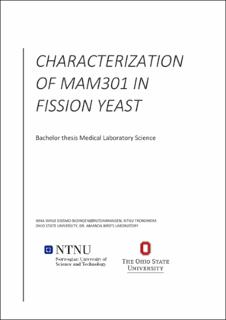| dc.description.abstract | Background: Magnesium is an essential ion that is a cofactor for many important proteins and enzymes in the body. It also functions as a counterion for negative ions and thus helps stabilize many important molecules. Although magnesium is vital for life, in excess, magnesium can be toxic and can lead to muscular paralysis and respiratory failure. In humans, genetic mutations in CNNM2 and CNNM4 interfere with magnesium homeostasis and cause the genetic diseases familial hypomagnesemia and Jalili syndrome. It is currently not clear if this protein transport or sense magnesium. The objective of this study was to gain new insight into the function of these proteins by characterizing the homologous gene Mam301 in Schizosaccharomyces pombe.
Methods: To investigate the function of Mam301 from fission yeast, the Mam301 protein was tagged with GFP (green fluorescent protein) to visualize the protein by microscopy and western blot analysis. To determine if Mam301 is important for growth in high or low magnesium, a series of drop tests were performed with wild-type and mam301 deletion cells. Western blot analysis was used to determine if Mam301 protein levels were dependent upon magnesium ion concentration. Additional experiments also examined the growth and regulatory function of Cis4 and Zrg17, two zinc transporters that are required for growth in high magnesium.
Results: The drop tests showed that Mam301 protects cells from high Mg2+ toxicity, and that cis4 and zrg17 deletions have higher sensitivity to high magnesium than a mam301 deletion. The western blot analyses show that Mam301 expression is dependent upon magnesium, and that the mam301 regulation is impaired in cells containing cis4 and zrg17 deletions.
Conclusion: The mam301 deletion showed growth inhibition with high magnesium, suggesting that Mam301 is important in protecting cells from high Mg2+. Further it was shown that Mam301 levels are regulated by magnesium levels up to 100 mM MgCl2, and that the function of Mam301 is impaired in the cis4 deletion strain. The latter strengthens the hypothesis that cis4 and probably zrg17 have an important regulatory role. | |
